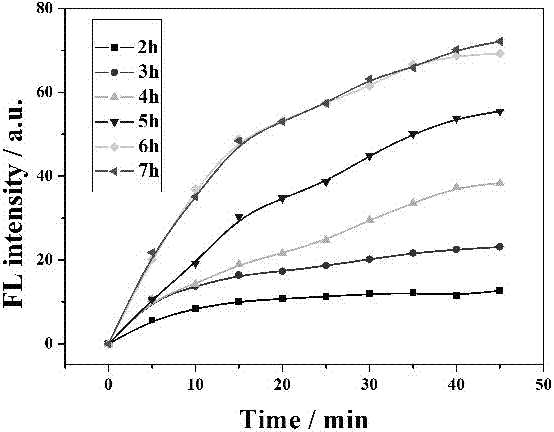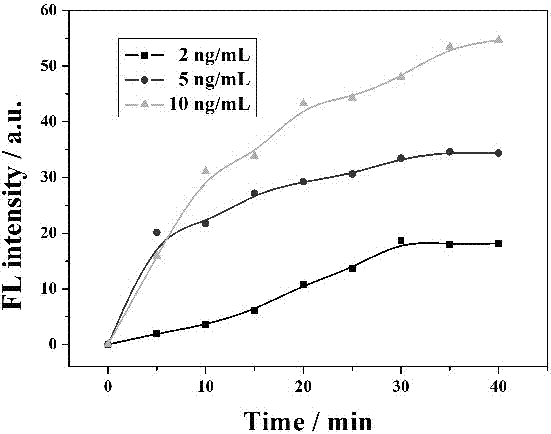Method for signal amplification fluorescence detection of aflatoxin B1 based on hybridization chain reaction and DNAzyme
A signal amplification and aflatoxin technology, which is applied in the fields of analytical chemistry and biosensing detection, can solve the problems of troublesome pretreatment of graphene oxide, harsh environment required for the reaction system, and failure to achieve signal amplification, etc., to achieve high Sensitivity and selectivity, high actual sample detection ability, effect of improving detection sensitivity
- Summary
- Abstract
- Description
- Claims
- Application Information
AI Technical Summary
Problems solved by technology
Method used
Image
Examples
Embodiment 1
[0027] Example 1: Establishment of a method for detecting aflatoxin B1 based on hybridization chain reaction and DNAzyme signal amplification and fluorescence detection
[0028] 1. Reaction time optimization for chain hybridization
[0029] figure 2 It is the corresponding fluorescence signal spectrum at different reaction times after adding the hairpin probe. It can be seen from the figure that within 2 to 6 hours, the fluorescent signal becomes stronger with the increase of the hybridization chain reaction time. When the reaction time is 7 hours, the signal is almost the same as that of 6 hours. Therefore, in the experiment We choose the reaction time of chain hybridization to be 6 hours.
[0030] 2. Fluorescence sensor sensitivity
[0031] The effect of reaction time on fluorescence intensity was investigated systematically. The results show that the addition of Mg to the system 2+ Finally, when the reaction time was 40min, the fluorescence signal was the strongest. ...
Embodiment 2
[0034] Embodiment 2: detection of aflatoxin B1 in moldy samples
[0035] After crushing 2 g of rice, add 6 mL of methanol / water solution (methanol:water=8:2), vortex for 30 min, centrifuge at 5000 rpm for 10 min, take the supernatant and filter it with a 0.45 μM filter head, and add different concentrations of The standard was made into the solution to be tested. Subsequently, detection was carried out according to the optimized conditions. Detection Table 2 is the detection data of aflatoxin B1 in the sample extract. From the data in Table 2 combined with the calculation of the concentration of the sample solution, it can be seen that the aflatoxin content is about 9.24±1.34 ng / g and 7.82±0.62 ng / g, which has exceeded the European standard of 2 μg / kg and is close to the national standard of 10 μg / kg, indicating that Moldy samples contain a certain amount of aflatoxin B1 and are not edible.
[0036] Table 2 Determination of aflatoxin B1 content in actual samples
[0037] ...
PUM
 Login to View More
Login to View More Abstract
Description
Claims
Application Information
 Login to View More
Login to View More - R&D
- Intellectual Property
- Life Sciences
- Materials
- Tech Scout
- Unparalleled Data Quality
- Higher Quality Content
- 60% Fewer Hallucinations
Browse by: Latest US Patents, China's latest patents, Technical Efficacy Thesaurus, Application Domain, Technology Topic, Popular Technical Reports.
© 2025 PatSnap. All rights reserved.Legal|Privacy policy|Modern Slavery Act Transparency Statement|Sitemap|About US| Contact US: help@patsnap.com



